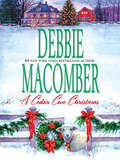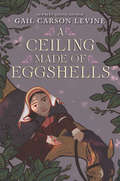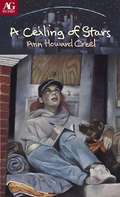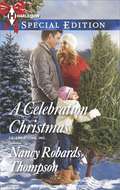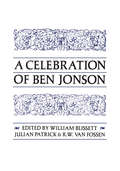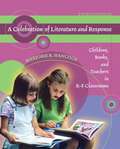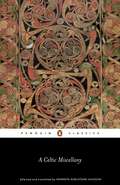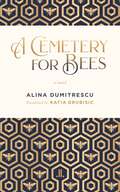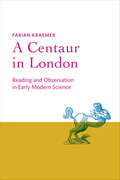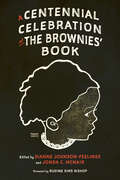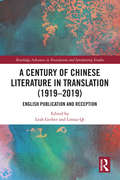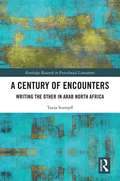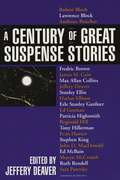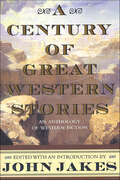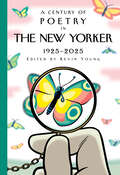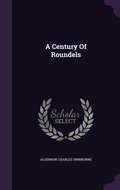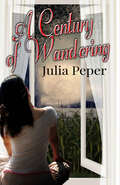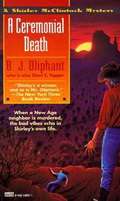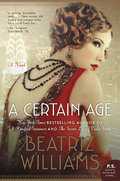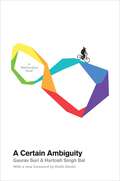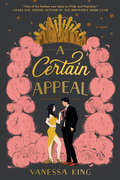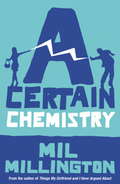- Table View
- List View
A Cedar Cove Christmas
by Debbie MacomberMother-to-be Mary Jo Wyse arrives in Cedar Cove on Christmas Eve, searching for her baby's father. David Rhodes had said he'd be in town. But he isn't. Which leaves Mary Jo stranded, pregnant and alone. And there's no room at the local inn. . . . So Grace Harding brings Mary Jo home to her nearby ranch. She and her husband, Cliff, have a houseful of guests, but they offer her a room over their stable (currently sheltering the animals--including a donkey and a camel--for Cedar Cove's Nativity pageant!). When Mary Jo goes into labor that night, a young man named Mack McAfee, a paramedic, comes to her rescue, just as her brothers--the three Wyse men--show up in town. The people of Cedar Cove join them in celebrating the birth of baby Noel. But no one has more to celebrate than Mack. Because this Christmas brings him faith, hope and love. . .
A Cedar Cove Christmas
by Debbie MacomberMother-to-be Mary Jo Wyse arrives in Cedar Cove on Christmas Eve, searching for her baby's father. David Rhodes had said he'd be in town. But he isn't. Which leaves Mary Jo stranded, pregnant and alone. And there's no room at the local inn....So Grace Harding brings Mary Jo home to her nearby ranch. She and her husband, Cliff, have a houseful of guests, but they offer her a room over their stable (currently sheltering the animals-including a donkey and a camel-for Cedar Cove's Nativity pageant!).When Mary Jo goes into labor that night, a young man named Mack McAfee, a paramedic, comes to her rescue, just as her brothers-the three Wyse men-show up in town. The people of Cedar Cove join them in celebrating the birth of baby Noel. But no one has more to celebrate than Mack. Because this Christmas brings him faith, hope and love...
A Ceiling Made of Eggshells
by Gail Carson LevineIn A Ceiling Made of Eggshells, Newbery Honor-winning author Gail Carson Levine tells a moving and ambitious story set during the expulsion of Jews from Spain, about a young Jewish girl full of heart who must play her own role in her people’s epic history—no matter the sacrifice. Surrounded by her large family, Loma is happy living in the judería of Alcalá de Henares, Spain, and wants nothing more than to someday have a family of her own. Still, when her intimidating grandfather, her Belo, decides to bring her along on his travels, she’s excited to join him. Belo has the ear of King Ferdinand and Queen Isabella, and Loma relishes her adventures with him, adventures that are beyond the scope of most girls of the time. She soon learns just how dangerous the world is for the Jews of Spain, and how her grandfather’s influence keeps their people safe. But the older Loma gets, the more she longs to realize her own dreams—if Belo will ever allow her to leave his side.
A Ceiling of Stars (American Girl)
by Ann Howard CreelThese contemporary novels feature girls who face everyday challenges and more serious problems as they approach their teen years. In figuring out how to cope when life is less than perfect, they begin to understand what growing up is all about. When her mother abandons her, 12-year-old Vivien must face her sudden homelessness alone in a big city. Vivien tells her story through a series of heartfelt letters and journal entries -- and reveals a touching sense of hope.
A Celebration Christmas
by Nancy Robards ThompsonTHE GREATEST GIFT OF ALL Lily Palmer is in for the Christmas of a lifetime! When the nanny signs up to watch Dr. Cullen Dunlevy's four foster kids, she's got her hands full. The Thomas clan is the most mischievous group of youngsters she's ever had to wrangle, but Lily loves the job. After all, what girl wouldn't adore spending the holidays with a warmhearted new family-and their irresistibly handsome foster dad? Cullen doesn't mind Christmas, but his Scrooge-like facade is there for a reason-to protect himself. His tough childhood caused him to hide behind his work and avoid entanglements at all costs. That includes avoiding falling for the deliciously tempting new nanny that Santa left for him this year...
A Celebration of Ben Jonson
by William F. Blissett Julian Patrick R.W. Van FossenThe papers in this volume were given by some of the world's foremost Jonsonian scholars at a conference at the University of Toronto which marked the 400th anniversary of his birth. Each contributor came from a different institution, and Canada, the United States, Great Britain, and New Zealand were represented. The balance of papers likewise reflects the range of Ben Jonson's achievement and the combination of brio and control so characteristic of him.The papers arrange themselves in pairs: 'The Incredibility of Jonsonian Comedy,' as discussed by Professor Clifford Leech, is of a piece with distrust and defiance of the audience as discussed in the paper 'Jonson and the Loathèd Stage' by Professor Jonas Barish; Professor George Hibbard in 'Ben Jonson and Human Nature' and Professor D.I. McKenzie in 'The Staple of News and the Late Plays' offer critical assessment of plays, the one wide-ranging, the other closely focused on a previously neglected play; and Professor H.N. Maclean in '"A More Secret Cause": The Wit of Jonson's Poetry' and Professor L.C. Knights in 'Ben Jonson: Public Attitudes and Social Poetry' approach the difficult and rewarding task of defining Jonson's poetry of appraisal in different but complementary styles.
A Celebration of Literature and Response: Children, Books, and Teachers in K-8 Classrooms
by Marjorie R. HancockThis engaging book applies reader response theory to children's literature methods to help new and experienced teachers best involve kindergarteners through eighth graders in literature and literacy. Authentic student responses open chapters, book clusters and the accompanying CD database of children's literature provide guidance for involving students with literature, and Literature Resources on the Web guide users to lesson plans, standards, author interviews, projects, and other Internet resources to enrich teaching. For teachers of Children's Literature.
A Celtic Miscellany: Selected and Translated by Kenneth Hurlstone Jackson
by Kenneth Hurlstone JacksonIncluding works from Welsh, Irish and Scottish Gaelic, Cornish, Breton and Manx, this Celtic Miscellany offers a rich blend of poetry and prose from the eighth to the nineteenth century, and provides a unique insight into the minds and literature of the Celtic people. It is a literature dominated by a deep sense of wonder, wild inventiveness and a profound sense of the uncanny, in which the natural world and the power of the individual spirit are celebrated with astonishing imaginative force. Skifully arranged by theme, from the hero-tales of Cú Chulainn, Bardic poetry and elegies, to the sensitive and intimate writings of early Celtic Christianity, this anthology provides a fascinating insight into a deeply creative literary tradition.
A Cemetery for Bees: A Novel
by Alina DumitrescuIn this series of poetic vignettes, the author describes growing up in Rumania under a totalitarian government and her emigration to Montreal as a young woman with a child. Life in her Rumanian village centers around holidays, church, family, and food, yet the drums of war are never far off. In Canada at last, the author tries to make sense of new customs, new expectations, and a language she does not fully understand. She counts on "those who know" to keep the world running while she tries to thread her way through the confusion of life.
A Centaur in London: Reading and Observation in Early Modern Science (Information Cultures)
by Fabian KraemerA nuanced reframing of the dual importance of reading and observation for early modern naturalists.Historians traditionally argue that the sciences were born in early modern Europe during the so-called Scientific Revolution. At the heart of this narrative lies a supposed shift from the knowledge of books to the knowledge of things. The attitude of the new-style intellectual broke with the text-based practices of erudition and instead cultivated an emerging empiricism of observation and experiment. Rather than blindly trusting the authority of ancient sources such as Pliny and Aristotle, practitioners of this experimental philosophy insisted upon experiential proof. In A Centaur in London, Fabian Kraemer calls a key tenet of this master narrative into question—that the rise of empiricism entailed a decrease in the importance of reading practices. Kraemer shows instead that the early practices of textual erudition and observational empiricism were by no means so remote from one another as the traditional narrative would suggest. He argues that reading books and reading the book of nature had a great deal in common—indeed, that reading texts was its own kind of observation. Especially in the case of rare and unusual phenomena like monsters, naturalists were dependent on the written reports of others who had experienced the good luck to be at the right place at the right time. The connections between compiling examples from texts and from observation were especially close in such cases. A Centaur in London combines the history of scholarly reading with the history of scientific observation to argue for the sustained importance of both throughout the Renaissance and provides a nuanced, textured portrait of early modern naturalists at work.
A Centennial Celebration of The Brownies’ Book (Children's Literature Association Series)
by Dianne Johnson-Feelings and Jonda C. McNairContributions by Jani L. Barker, Rudine Sims Bishop, Julia S. Charles-Linen, Paige Gray, Dianne Johnson-Feelings, Jonda C. McNair, Sara C. VanderHaagen, and Michelle Taylor WattsThe Brownies’ Book occupies a special place in the history of African American children’s literature. Informally the children’s counterpart to the NAACP’s The Crisis magazine, it was one of the first periodicals created primarily for Black youth. Several of the objectives the creators delineated in 1919 when announcing the arrival of the publication—“To make them familiar with the history and achievements of the Negro race” and “To make colored children realize that being ‘colored’ is a beautiful, normal thing”—still resonate with contemporary creators, readers, and scholars of African American children’s literature. The meticulously researched essays in A Centennial Celebration of "The Brownies’ Book" get to the heart of The Brownies’ Book “project” using critical approaches both varied and illuminating. Contributors to the volume explore the underappreciated role of Jessie Redmon Fauset in creating The Brownies’ Book and in the cultural life of Black America; describe the young people who immersed themselves in the pages of the periodical; focus on the role of Black heroes and heroines; address The Brownies’ Book in the context of critical literacy theory; and place The Brownies’ Book within the context of Black futurity and justice. Bookending the essays are, reprinted in full, the first and last issues of the magazine. A Centennial Celebration of "The Brownies’ Book" illuminates the many ways in which the magazine—simultaneously beautiful, complicated, problematic, and inspiring—remains worthy of attention well into this century.
A Century of Chinese Literature in Translation: English Publication and Reception (Routledge Advances in Translation and Interpreting Studies)
by Leah Gerber; Lintao QiThis book delves into the Chinese literary translation landscape over the last century, spanning critical historical periods such as the Cultural Revolution in the greater China region. Contributors from all around the world approach this theme from various angles, providing an overview of translation phenomena at key historical moments, identifying the trends of translation and publication, uncovering the translation history of important works, elucidating the relationship between translators and other agents, articulating the interaction between texts and readers and disclosing the nature of literary migration from Chinese into English. This volume aims at benefiting both academics of translation studies from a dominantly Anglophone culture and researchers in the greater China region. Chinese scholars of translation studies will not only be able to cite this as a reference book, but will be able to discover contrasts, confluence and communication between academics across the globe, which will stimulate, inspire and transform discussions in this field.
A Century of Encounters: Writing the Other in Arab North Africa (Routledge Research in Postcolonial Literatures)
by Tanja StampflA Century of Encounters analyzes Arab, American, and European literary depictions of self and other as they interact with each other in Arab North Africa throughout the twentieth century and introduces the trope of the encounter as a lens through which to read contemporary world literature comparatively. A focus on the transnational encounter allows for the in-depth study of constructions of gender, race, and national identities both for the self and the other in order to answer the seemingly simple questions: What makes up different encounters in the twentieth century, and how can we facilitate a productive and positive encounter between these groups? This book illustrates connections between literary texts that have hitherto been overlooked and establishes an intertextual genealogy of transcultural encounters throughout the twentieth century that coalesce around the themes of desire, family, and travel. In its literary analysis, A Century of Encounters aims to facilitate a better understanding of other cultures in general and contribute to constructive cross-cultural interactions between the United States, Europe, and Arab North Africa in particular.
A Century of Fiction in The New Yorker: 1925-2025
by New Yorker Magazine IncEdited by The New Yorker's fiction editor, Deborah Treisman, a celebratory selection from one hundred years of short stories in the magazine which has been the most influential and important showcase for the form and has launched dozens of stellar careers in fictionThere is simply no A–Z like the alphabet of fiction writers who have appeared in the pages of The New Yorker in the last hundred years. The book boasts inarguable classics like Salinger&’s &“A Perfect Day for Bananafish,&” Annie Proulx&’s &“Brokeback Mountain,&” and Shirley Jackson&’s &“The Lottery&” alongside stunners to be rediscovered. Some stories defined a moment or a now-lost world (Isaac Bashevis Singer&’s &“The Cafeteria&”); others showed us a whole new way fiction could sound and feel (&“The Red Girl,&” by Jamaica Kincaid). With this vivid selection, Treisman showcases how our fiction has changed over time, and reminds us that past literary fashions continue to ripple outward in the fiction we love today. What does a Donald Barthelme mean to the craft of short fiction now? What will a Yiyun Li mean to the next generation of readers and writers? This exquisite tour of the form as practiced at its highest level will leap directly into the hearts of readers of all ages, all stripes, and is a beautiful tribute to the magazine's influence on our literary culture over the last century.
A Century of Great Suspense Stories
by Various Jeffery DeaverNew York Times bestselling author Jeffery Deaver's enviable task? Choose the best mystery/horror detective stories from a century of work by the world's most celebrated writers. The result is a triumph, featuring masterpieces of suspense by:<P> Robert Bernard * Robert Bloch * Lawrence Block * Anthony Boucher * Frederic Brown * James M. Cain * Max Allan Collins * Jeffery Deaver * Stanley Ellin * Harlan Ellison * Erle Stanley Gardner * Ed Gorman * Anna Katharine Green * Jeremiah Healy * Patricia Highsmith * Reginald Hill * Tony Hillerman * Evan Hunter * Stephen King * John Lutz * John D. MacDonald * Ross MacDonald * Michael Malone * Steve Martini * Sharyn McCrumb * Margaret Millar * Marcia Muller * Sara Paretsky * Bill Pronzini * Ellery Queen * Ruth Rendell * Lisa Scottoline * Georges Simenon * Mickey Spillane * Rex Stout * Janwillem van de Wetering * Donald E. Westlake
A Century of Great Western Stories: An Anthology of Western Fiction
by John JakesJohn Jakes, #1 New York Times bestselling author of such acclaimed historical novels as North and South and The Kent Family Chronicles compiled in one volume a century's worth of his favorite American Western fiction. To illustrate the evolution of the genre, Jakes has included such legendary authors as Owen Wister, Louis L'Amour, and Zane Grey along side their more contemporary peers such as Loren Estleman and Elmer Kelton. While the stories have changed over the years, certain timeless themes of Western fiction remain constant. At the heart of the stories are ideas that have become synonymous with the American dream--the frontier spirit, individual freedoms, and man's relationship with the land. A Century of Great Western Stories is essentially a retrospective of western writing over the past century, but Jakes also sets out to give readers a glimpse of what the future might hold for western fiction. While trends in publishing might not always be promising, the current crop of contemporary Western authors show that the old west will always have a place in the world of fiction. Like the American dream which it celebrates, Western fiction will persevere.At the Publisher's request, this title is being sold without Digital Rights Management Software (DRM) applied.
A Century of Poetry in The New Yorker: 1925-2025
by New Yorker Magazine IncEdited by the magazine&’s poetry editor, Kevin Young, a celebratory selection from one hundred years of influential, entertaining, and taste-making verse in The New YorkerSeamus Heaney, Dorothy Parker, Louise Bogan, Louise Glück, Randall Jarrell, Langston Hughes, Derek Walcott, Sylvia Plath, W. S. Merwin, Czesław Miłosz, Tracy K. Smith, Mark Strand, E. E. Cummings, Sharon Olds, Franz Wright, John Ashbery, Sandra Cisneros, Amanda Gorman, Maggie Smith, Kaveh Akbar: these stellar names make up just a fraction of the wonderfulness that is present in this essential anthology.The book is organized into sections honoring times of day (&“Morning Bell,&” &“Lunch Break,&” &“After-Work Drinks,&” &“Night Shift&”), allowing poets from different eras to talk back to one another in the same space, intertwined with chronological groupings from the decades as they march by: the frothy 1920s and 1930s (&“despite the depression,&” Young notes), the more serious &’40s and &’50s (introducing us to the early greats of our contemporary poetry, like Elizabeth Bishop, W. S. Merwin, and Adrienne Rich), the political &’60s and &’70s, the lyrical &’80s and &’90s, and then the 2000s&’ with their explosion of greater diversity in the magazine, greater depth and breadth. Inevitably, we see the high points when poems spoke directly into, about, or against the crises of their times—the war poetry of W. H. Auden and Karl Shapiro; the remarkable outpouring of verse after 9/11 (who can forget Adam Zagajewski&’s &“Try to Praise the Mutilated World&”?); and more recently, stunning poems in response to the cataclysmic events of COVID and the murder of George Floyd.The magazine&’s poetic influence resides not just in this historical and cultural relevance but in sheer human connection, exemplified by the passing verses that became what Young calls &“refrigerator poems&”: the ones you tear out and affix to the fridge to read again and again over months and years. Our love for that singular Billy Collins or Ada Limón poem—or lines by a new writer you&’ve never heard of but will hear much more from in the future—is what has made The New Yorker a great organ for poetry, a mouthpiece for our changing culture and way of life, even a mirror of our collective soul.
A Century of Roundels
by Algernon Charles SwinburneSongs light as these may sound, though deep and strong The heart spake through them, scarce should hope to please Ears tuned to strains of loftier thoughts than throng Songs light as these. <P> <P> Yet grace may set their sometime doubt at ease, Nor need their too rash reverence fear to wrong The shrine it serves at and the hope it sees. For childlike loves and laughters thence prolong Notes that bid enter, fearless as the breeze, Even to the shrine of holiest-hearted song, Songs light as these. (Typographical errors above are due to OCR software and don't occur in the book.)
A Century of Wandering
by Julia Peper<p>A couple’s move to an old West Virginia house stirs up a haunting hundred-year-old mystery . . .<p> <p>June 23, 1923: Local Couple Disappears Under Suspicious Circumstances<p> <p>Thanks to a new job opportunity, and with their children now grown, Mary and her husband, Rick, have moved from Indiana into a one-hundred-year-old home in West Virginia. But while adjusting to such a big change in her life, she has no idea that she is about to encounter the ghost of a woman named Jillian—and become instrumental in helping her solve the mystery of how she and her beloved disappeared without a trace so long ago, after the warm moonlit night they planned to meet under the old oak tree and elope . . .<p>
A Ceremonial Death
by B. J. OliphantShadow Dancer Was Readying Her Hogan For A Healing Ceremony -- and Her Own Terrible Death. . . . And the beautiful cosmic healer, nee Bridget McCree, had not been dead long when her neighbor Shirley McClintock found her viciously mutilated body. Was the murder the work of extraterrestrials, as recent cattle mutilations in the Santa Fe area are believed to be? Shirley's investigation into Shadow Dancer's torrid romances and tangled family affairs suggests more traditional motivations: greed, lust, and envy. So after a second sordid killing and sly rumors that Shirley and her family are somehow involved in both crimes, she goes on the warpath: straight toward the unexpected truth and a head-on confrontation with Shadow Dancer's murderous last client. . .
A Certain Age: A Novel
by Beatriz WilliamsThe bestselling author of A Hundred Summers brings the Roaring Twenties brilliantly to life in this enchanting and compulsively readable tale of intrigue, romance, and scandal in New York Society, brimming with lush atmosphere, striking characters, and irresistible charm.As the freedom of the Jazz Age transforms New York City, the iridescent Mrs. Theresa Marshall of Fifth Avenue and Southampton, Long Island, has done the unthinkable: she's fallen in love with her young paramour, Captain Octavian Rofrano, a handsome aviator and hero of the Great War. An intense and deeply honorable man, Octavian is devoted to the beautiful socialite of a certain age and wants to marry her. While times are changing and she does adore the Boy, divorce for a woman of Theresa's wealth and social standing is out of the question, and there is no need; she has an understanding with Sylvo, her generous and well-respected philanderer husband.But their relationship subtly shifts when her bachelor brother, Ox, decides to tie the knot with the sweet younger daughter of a newly wealthy inventor. Engaging a longstanding family tradition, Theresa enlists the Boy to act as her brother's cavalier, presenting the family's diamond rose ring to Ox's intended, Miss Sophie Fortescue--and to check into the background of the little-known Fortescue family. When Octavian meets Sophie, he falls under the spell of the pretty ingénue, even as he uncovers a shocking family secret. As the love triangle of Theresa, Octavian, and Sophie progresses, it transforms into a saga of divided loyalties, dangerous revelations, and surprising twists that will lead to a shocking transgression . . . and eventually force Theresa to make a bittersweet choice.Full of the glamour, wit and delicious twists that are the hallmarks of Beatriz Williams' fiction and alternating between Sophie's spirited voice and Theresa's vibrant timbre, A Certain Age is a beguiling reinterpretation of Richard Strauss's comic opera Der Rosenkavalier, set against the sweeping decadence of Gatsby's New York.
A Certain Ambiguity: A Mathematical Novel
by Gaurav Suri Hartosh Singh BalWhile taking a class on infinity at Stanford in the late 1980s, Ravi Kapoor discovers that he is confronting the same mathematical and philosophical dilemmas that his mathematician grandfather had faced many decades earlier--and that had landed him in jail. Charged under an obscure blasphemy law in a small New Jersey town in 1919, Vijay Sahni is challenged by a skeptical judge to defend his belief that the certainty of mathematics can be extended to all human knowledge--including religion. Together, the two men discover the power--and the fallibility--of what has long been considered the pinnacle of human certainty, Euclidean geometry. As grandfather and grandson struggle with the question of whether there can ever be absolute certainty in mathematics or life, they are forced to reconsider their fundamental beliefs and choices. Their stories hinge on their explorations of parallel developments in the study of geometry and infinity--and the mathematics throughout is as rigorous and fascinating as the narrative and characters are compelling and complex. Moving and enlightening, A Certain Ambiguity is a story about what it means to face the extent--and the limits--of human knowledge.
A Certain Appeal
by Vanessa KingA sparkling contemporary retelling of Pride and Prejudice set in the tantalizing world of New York City burlesque, perfect for fans of The Kiss Quotient and The Roommate.After a betrayal derailed her interior design career, Liz Bennet found a fresh start in New York. Now an executive assistant by day and stage kitten by night, she&’s discovered a second home with the performers at Meryton, Manhattan&’s top-tier burlesque venue. Love&’s the last thing on her mind when she locks eyes with Will Darcy across the crowded club, yet the spark between them is undeniable—that is, until she overhears the uptight wealth manager call her merely &“tolerable.&” Bennet is determined to write Darcy off, but once their besties fall head-over-heels, they&’re thrown into each other&’s orbit again and again. Each encounter begins to feel more heated than the last, but is their chemistry enough to topple that terrible first impression? What&’s more, when a charming newcomer arrives on the scene with accusations against Darcy, and a sudden development leaves Meryton&’s fate in jeopardy, Bennet will have to decide who to trust in time to salvage her design dreams, her heart, and the stage she shares with her found family…
A Certain Chemistry: A Novel
by Mil MillingtonIs this love or just oxytocin? The brilliant second novel by the bestselling author of Things my Girlfriend and I Have Argued AboutTom Cartwright is a ghost-writer: eking out a living in Edinburgh, he is always ready to assumethe persona of a struggling working mother-of-four, or a round-the-world yachtsman, or a 'sensual' aromatherapist - indeed anyone his agent asks him to be, so long as it brings in money. When he is offered the highly lucrative task of ghosting the autobiography of glamorous young soap star Georgina Nye, he and his girlfriend Sara are thrilled: Sara is a big fan of George's and Tom will finally be able to afford some new carpets for their house.But soon things go awry when Tom finds himself drawn to George by forces outside his control (even though they are inside his own body). Does his relationship with Sara stand a chance in the face of this explosion of chemistry? Is this love or just oxytocin - and is there a difference?
A Certain Chemistry: A Novel
by Mil MillingtonIs this love or just oxytocin? The brilliant second novel by the bestselling author of Things my Girlfriend and I Have Argued AboutTom Cartwright is a ghost-writer: eking out a living in Edinburgh, he is always ready to assumethe persona of a struggling working mother-of-four, or a round-the-world yachtsman, or a 'sensual' aromatherapist - indeed anyone his agent asks him to be, so long as it brings in money. When he is offered the highly lucrative task of ghosting the autobiography of glamorous young soap star Georgina Nye, he and his girlfriend Sara are thrilled: Sara is a big fan of George's and Tom will finally be able to afford some new carpets for their house.But soon things go awry when Tom finds himself drawn to George by forces outside his control (even though they are inside his own body). Does his relationship with Sara stand a chance in the face of this explosion of chemistry? Is this love or just oxytocin - and is there a difference?
